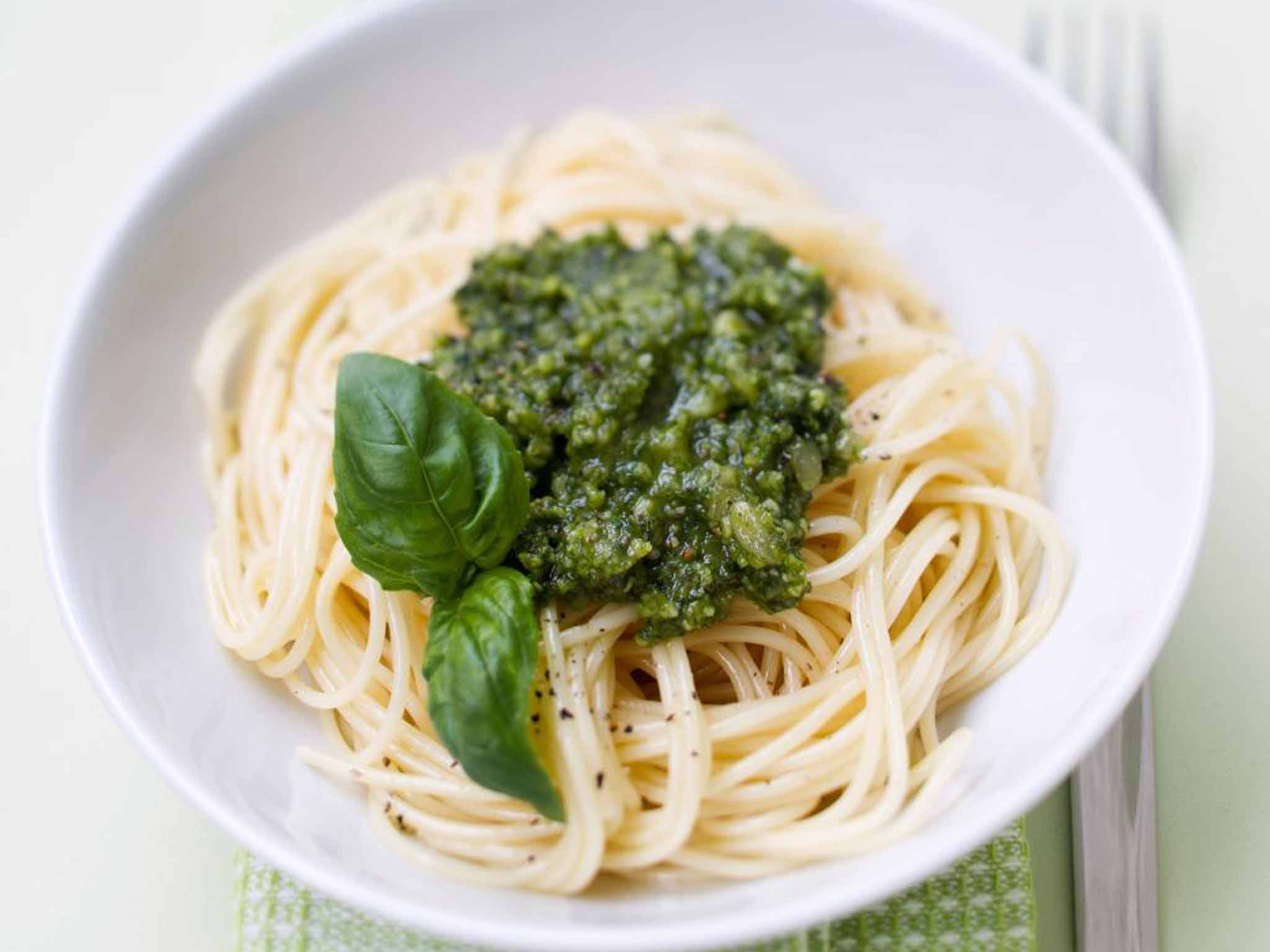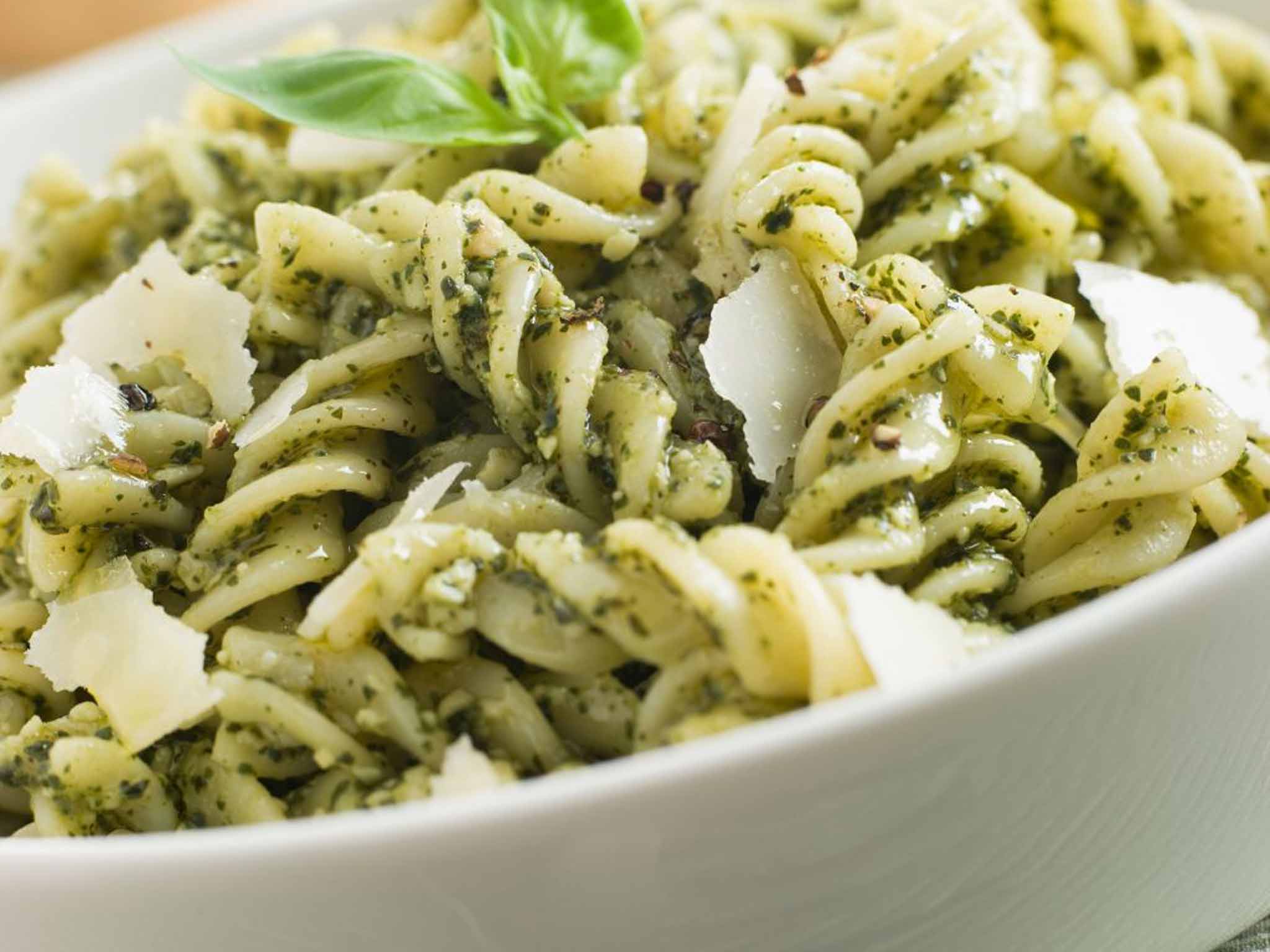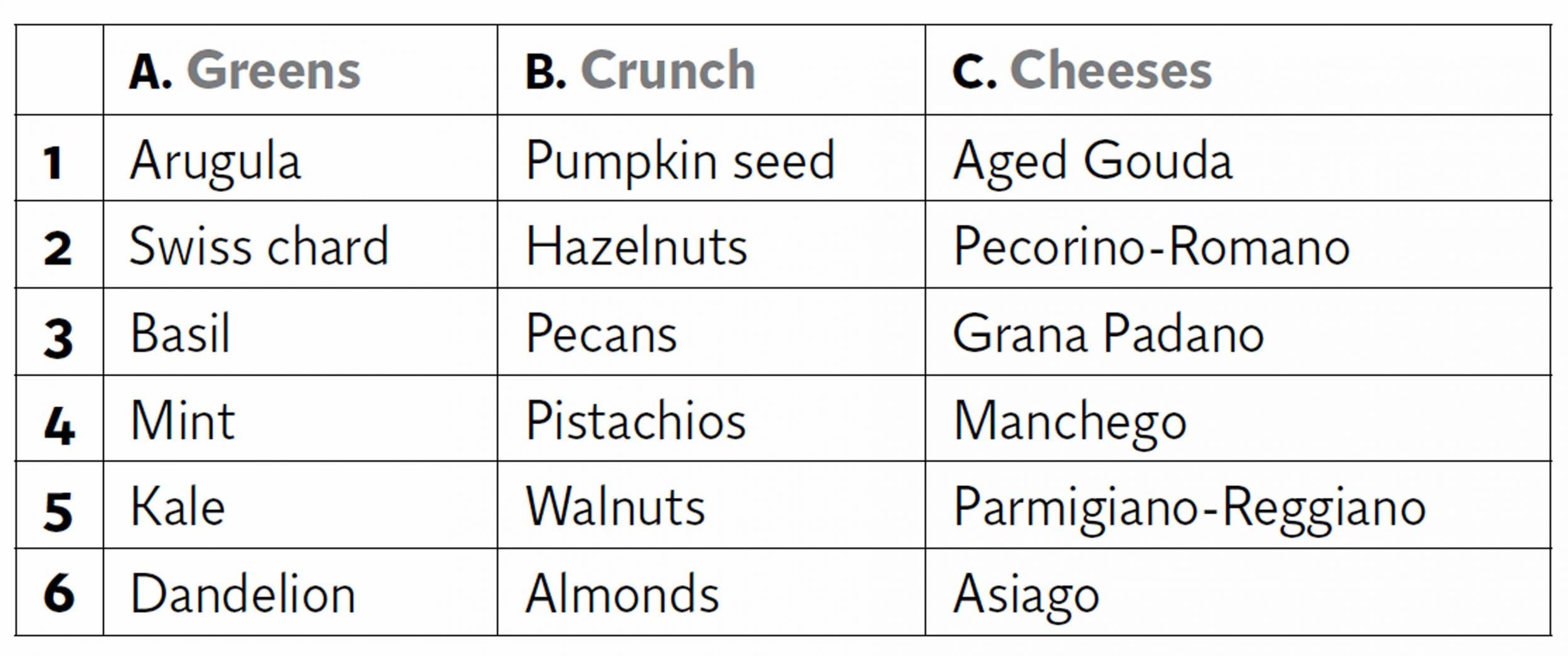Pesto with a twist: Experiment with mash-ups of mint or kale, pecans or pistachios
To the purist, pesto means basil, parmesan and pine nuts. For Jason Wilson, it's an opportunity to argue with tradition with just about any hard, aged cheese. Pestles at the ready!

Roberto Panizza is not amused by the pesto I describe, one I make at home with rocket, pumpkin seeds and aged Gouda cheese. He ruefully shakes his head. “I like pumpkin seed. It sounds like a nice sauce,” he says, still shaking his head. “But it is not a pesto.”
We're sitting at a table in Panizza's trattoria, Il Genovese, considered by many to be the high temple of pesto in Genoa, the Ligurian city that is the undisputed spiritual capital of the sauce. Pesto, in fact, is a candidate to become protected by Unesco as an “intangible cultural heritage”. To say that Panizza, organiser of the biannual Pesto World Championship, is a traditionalist would be an understatement. “Pesto is part of my life,” he says. “Pesto is not just a sauce, it's a technique, it's a part of culture. The ingredients tell a grand story.”
To Panizza, those ingredients are non-negotiable: special Genovese basil that's grown only in Liguria, special garlic that's grown only in the small village of Vessalico, Parmigiano-Reggiano, and Sardinian pecorino, the highest-quality extra virgin olive oil, salt and pine nuts. Basta cosi. As for technique, he insists that a pesto must be ground by a wooden pestle, using a circular motion, in a marble mortar. The word pesto, after all, derives from pestare, meaning to pound or crush. At Il Genovese, the marble mortar seems the size of a small bathtub, the pestle the size of a baseball bat. I don't even bother to ask about using a food processor. I already know Panizza's answer: no.

Panizza is still shaking his head about the pumpkin seeds and rocket, and says, “That would be like presenting, for your American Thanksgiving, a chicken and no turkey!” We tuck into a huge platter of testaroli (somewhere between a pasta and a crêpe) smothered in Il Genovese's amazing, velvety – and “correct” – pesto. It's like going to pesto church, and it's hard to argue with tradition. Hard, but not impossible. So I'm going to argue with tradition. I'm not the only one. Massimo Bottura, Italy's star postmodern chef, recently offered a recipe for pesto using – gasp – breadcrumbs and herbs salvaged from the scrapheap instead of pine nuts and basil. That was during Milan Expo 2015, as part of a pop-up charity he ran to feed the homeless. Now, Bottura serves it in his restaurant. Of course, in the United States, where I live, we've never really cared about tradition and never needed an excuse to fool around with such a dish (recall sundried tomato pesto?).
The first pesto recipe published in a US magazine was in Sunset in 1946. It still took another three decades to catch on, not garnering more than a handful of mentions in The New York Times, for instance, until the mid-1970s. Then, in the early 1980s, pesto's popularity exploded, just as it did in Britain. Its staying power as a food trend lasted well into the early 2000s. By then, pesto was old hat. You could have it slathered on a chicken salad at McDonald's.
A further challenge to traditional pesto is the recent news that the pine nut industry might be destroying an ecosystem in Russia's far east, where the Korean pine tree is unsustainably harvested. In October, Jonathan Slaght of the Wildlife Conversation Society wrote an article in The New York Times, pleading with cooks to stop using pine nuts. “The Korean pine nut pesto you eat today thus carries with it an unseen cost,” Slaght wrote.
Beyond ecological concerns, good pine nuts are crazily expensive. And if you buy cheap ones imported from China, there's a chance you will develop the dreaded “pine-nut mouth”, a condition that makes everything taste awful for a week or more.
In any case, there are plenty of nutty alternatives. Whether or not traditionalists will scold you for calling it “pesto”, you can make it with walnuts, hazelnuts, pistachios, almonds, pecans and, yes, pumpkin seeds. With the alternative nuts, just make sure you allow time to toast or blanch, and then cool, before using them in pesto. Besides the nuts, I assert that you can and should experiment with the other components, including the basil and the cheese. Panizza describes pesto as “a garlic sauce aromatised by the basil”. Given that logical explanation, there's no reason why one can't aromatise the garlic with lots of different greens. I've made great pestos with Swiss chard, mint, parsley, dandelion and kale.
Many of us also still think narrowly when it comes to the cheese (always Italian, usually Parmesan or pecorino), but just about any hard, aged cheese theoretically could work, including Dutch Gouda, Spanish manchego and some artisan domestic renditions. I've also done a little experimenting with different oils, using grapeseed and even avocado oil with some interesting results. For now, however, I mainly use the traditional olive oil. Good garlic and good sea salt are not negotiable.
As for technique, I must confess that even though I have a beautiful mortar and pestle that I brought home from Genoa, I rarely use it. A prime grinding technique is tricky to master, so most of the time, like most home cooks, I use a food processor. I will say, however, that when I take the time to do it with the mortar and pestle, the results are richer, more velvety, and wonderful.
Beyond the mortar and pestle, Panizza insists there is no real secret. “It's all about experience and sensibility,” he says. “Then it's a question of grams and sequence.”
Panizza's sequence is first to mash the garlic and pine nuts with a generous pinch of salt, then to add the basil, grinding until it begins to bleed green liquid, at which point he adds the cheese and then drizzles in the oil. That order works well with the mortar-and-pestle method. But for the food processor, I like to start with the greens, followed by the garlic and salt, followed by nuts, then the cheese, and finally the drizzled oil.
Near the end of our lunch, after we finish the testaroli and move on to perfect pesto-enveloped trofie, I finally unburden my conscience and tell Panizza that I mostly use a food processor at home. He sighs and says that even in Italy, this is the modern reality. “These days,” he says, “a lot of Italian families still have the mortar and pestle. But they put a plant in it!”
Suddenly, I feel a little better about my rocket-pumpkin seed-Gouda pesto.
Pesto generator
Traditionalists insist that pesto must be made of basil, pine nuts, parmigiano-reggiano or pecorino-romano cheese, garlic and oil. But tradition be damned; great pesto can be made from all sorts of greens, nuts and cheeses.
To create a new pesto, choose one each from columns A, B and C. Mix and match. Experiment. Innovate. Or, try one of the six combinations in the rows below, for which we've included some tasting notes.
Follow this basic ratio: 2 packed cups of greens (1 cup = 8oz/200g), 1 to 2 cloves of garlic, half a cup of nuts, half a cup of cheese and half a cup of olive oil. Taste and add salt as needed.

Notes on these combinations
1. This is great on fresh pasta and slathered on toast.
2. The chard gives this pesto a particularly rich shade of green.
3. Toasted pecans elevate the flavour here; the pesto is also great with chicken.
4. Parsley will add complexity to the mix; this pairs well with fish.
5. Hearty, this pesto is a good choice for wholewheat pastas.
6. Mild flavours make this nice for spring dishes.
Tips
µ In a food processor, begin with the greens, followed by the garlic and salt, nuts, cheese and then oil. In a pestle and mortar, mash the garlic and salt into a paste, then the nuts, the greens, the cheese and the oil.
µ For heartier greens such as Swiss chard and kale, be sure to blanch, then cool in ice water before using.
µ Always toast or blanch the nuts for more flavour.
µ Experiment with oils – try grapeseed or avocado.
Jason Wilson is author of the new Kindle Single 'Spaghetti on the Wall'.
© The Washington Post
Join our commenting forum
Join thought-provoking conversations, follow other Independent readers and see their replies
Comments